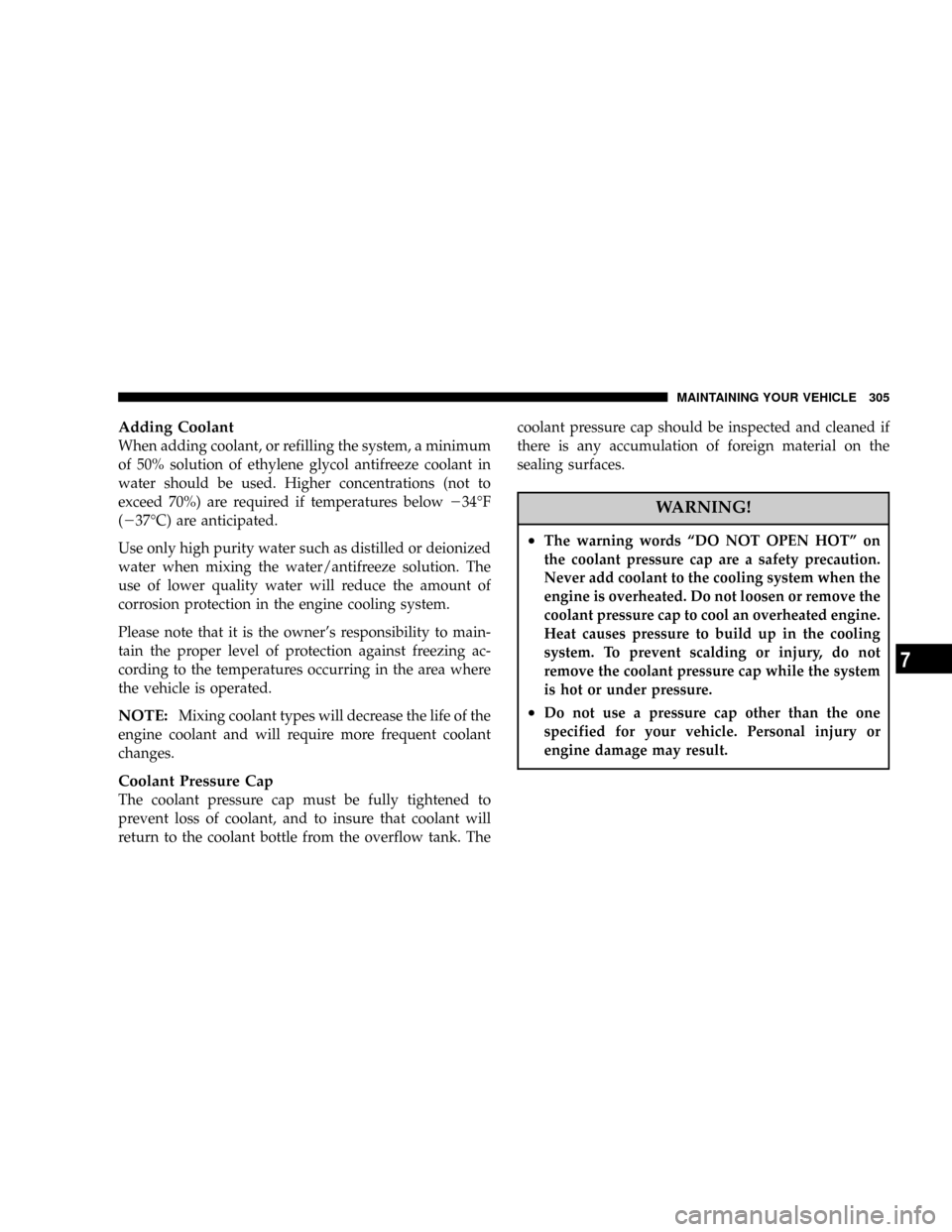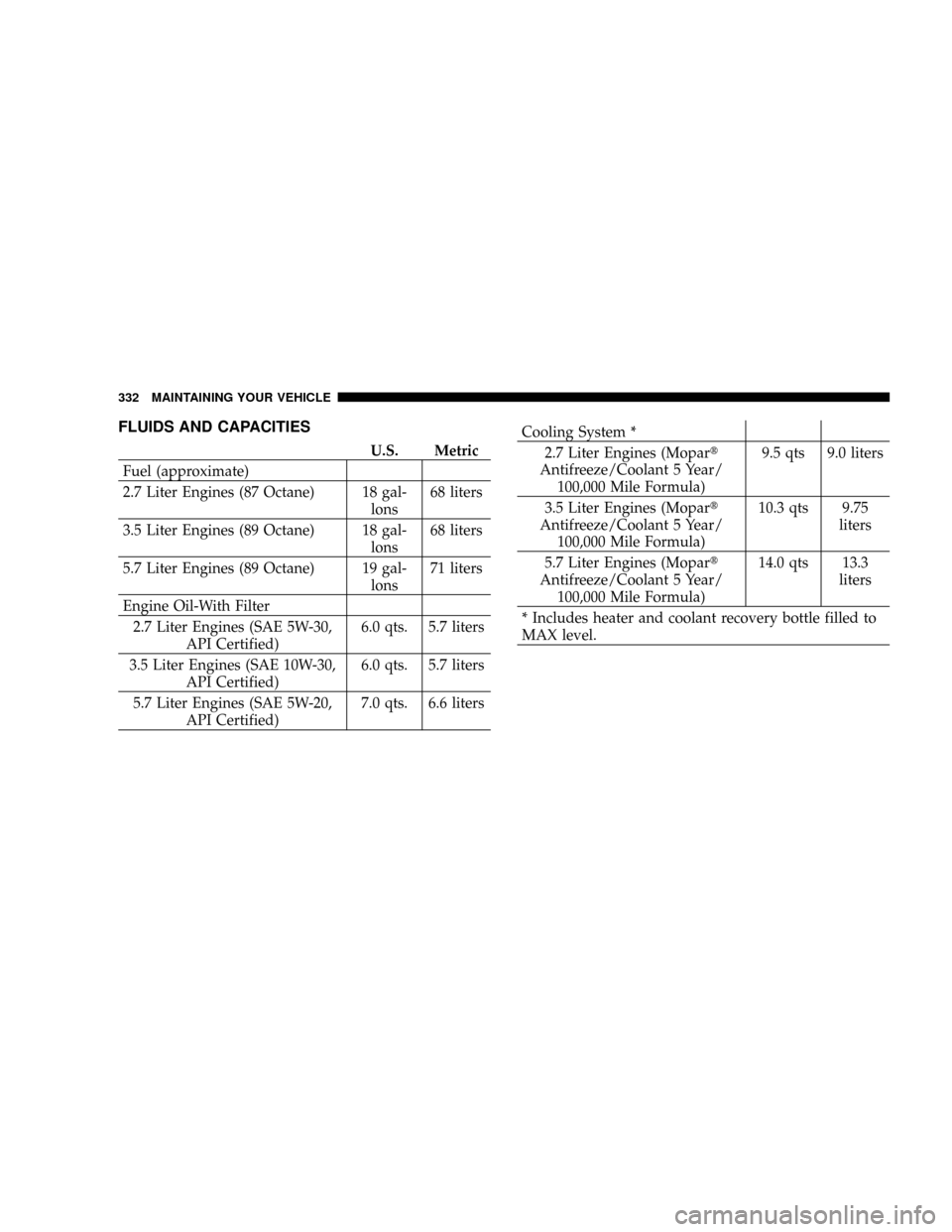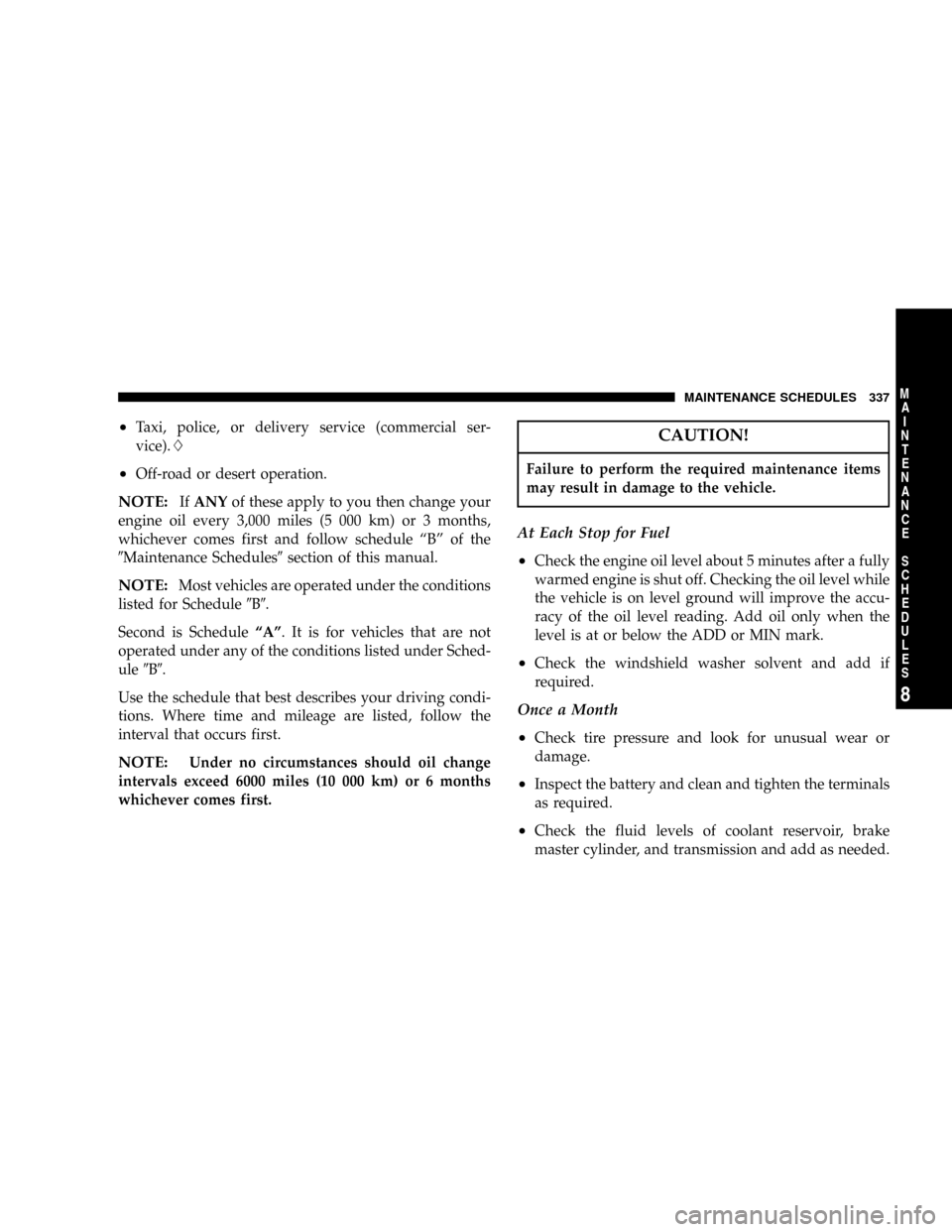2005 CHRYSLER 300 coolant level
[x] Cancel search: coolant levelPage 305 of 374

Adding Coolant
When adding coolant, or refilling the system, a minimum
of 50% solution of ethylene glycol antifreeze coolant in
water should be used. Higher concentrations (not to
exceed 70%) are required if temperatures below234ÉF
(237ÉC) are anticipated.
Use only high purity water such as distilled or deionized
water when mixing the water/antifreeze solution. The
use of lower quality water will reduce the amount of
corrosion protection in the engine cooling system.
Please note that it is the owner's responsibility to main-
tain the proper level of protection against freezing ac-
cording to the temperatures occurring in the area where
the vehicle is operated.
NOTE:Mixing coolant types will decrease the life of the
engine coolant and will require more frequent coolant
changes.
Coolant Pressure Cap
The coolant pressure cap must be fully tightened to
prevent loss of coolant, and to insure that coolant will
return to the coolant bottle from the overflow tank. Thecoolant pressure cap should be inspected and cleaned if
there is any accumulation of foreign material on the
sealing surfaces.
WARNING!
²The warning words ªDO NOT OPEN HOTº on
the coolant pressure cap are a safety precaution.
Never add coolant to the cooling system when the
engine is overheated. Do not loosen or remove the
coolant pressure cap to cool an overheated engine.
Heat causes pressure to build up in the cooling
system. To prevent scalding or injury, do not
remove the coolant pressure cap while the system
is hot or under pressure.
²Do not use a pressure cap other than the one
specified for your vehicle. Personal injury or
engine damage may result.
MAINTAINING YOUR VEHICLE 305
7
Page 306 of 374

Disposal of Used Engine Coolant
Used ethylene glycol based engine coolant is a regulated
substance requiring proper disposal. Check with your
local authorities to determine the disposal rules for your
community. To prevent ingestion by animals or children
do not store ethylene glycol based engine coolant in open
containers or allow it to remain in puddles on the
ground. If ingested by a child, contact a physician
immediately. Clean up any ground spills immediately.
Coolant Level
The coolant bottle provides a quick visual method for
determining that the coolant level is adequate. With the
engine off and cold, the coolant level should be between
the ranges indicated on the bottle. Some darkening of the
coolant bottle will occur over time. This is normal.
When additional coolant is needed to maintain the
proper level, it should be added to the coolant bottle. Do
not overfill. See your authorized dealer to properly fill
the cooling system.
Points to Remember
NOTE:
When the vehicle is stopped after a few miles of
operation, you may observe vapor coming from the front
of the engine compartment. This is normally a result of
moisture from rain, snow, or high humidity accumulat-
ing on the radiator and being vaporized when the
thermostat opens, allowing hot coolant to enter the
radiator.
If an examination of your engine compartment shows no
evidence of radiator or hose leaks, the vehicle may be
safely driven. The vapor will soon dissipate.
²Do not overfill the coolant bottle.
²Check coolant freeze point in the system.
²If frequent coolant additions are required, the cooling
system should be pressure tested for leaks.
²Maintain coolant concentration at 50% ethylene glycol
antifreeze (minimum) in water for proper corrosion
protection of your engine which contains aluminum
components.
306 MAINTAINING YOUR VEHICLE
Page 332 of 374

FLUIDS AND CAPACITIES
U.S. Metric
Fuel (approximate)
2.7 Liter Engines (87 Octane) 18 gal-
lons68 liters
3.5 Liter Engines (89 Octane) 18 gal-
lons68 liters
5.7 Liter Engines (89 Octane) 19 gal-
lons71 liters
Engine Oil-With Filter
2.7 Liter Engines (SAE 5W-30,
API Certified)6.0 qts. 5.7 liters
3.5 Liter Engines (SAE 10W-30,
API Certified)6.0 qts. 5.7 liters
5.7 Liter Engines (SAE 5W-20,
API Certified)7.0 qts. 6.6 liters
Cooling System *
2.7 Liter Engines (Mopart
Antifreeze/Coolant 5 Year/
100,000 Mile Formula)9.5 qts 9.0 liters
3.5 Liter Engines (Mopart
Antifreeze/Coolant 5 Year/
100,000 Mile Formula)10.3 qts 9.75
liters
5.7 Liter Engines (Mopart
Antifreeze/Coolant 5 Year/
100,000 Mile Formula)14.0 qts 13.3
liters
* Includes heater and coolant recovery bottle filled to
MAX level.
332 MAINTAINING YOUR VEHICLE
Page 337 of 374

²Taxi, police, or delivery service (commercial ser-
vice).L
²Off-road or desert operation.
NOTE:IfANYof these apply to you then change your
engine oil every 3,000 miles (5 000 km) or 3 months,
whichever comes first and follow schedule ªBº of the
9Maintenance Schedules9section of this manual.
NOTE:Most vehicles are operated under the conditions
listed for Schedule9B9.
Second is ScheduleªAº. It is for vehicles that are not
operated under any of the conditions listed under Sched-
ule9B9.
Use the schedule that best describes your driving condi-
tions. Where time and mileage are listed, follow the
interval that occurs first.
NOTE:Under no circumstances should oil change
intervals exceed 6000 miles (10 000 km) or 6 months
whichever comes first.
CAUTION!
Failure to perform the required maintenance items
may result in damage to the vehicle.
At Each Stop for Fuel
²
Check the engine oil level about 5 minutes after a fully
warmed engine is shut off. Checking the oil level while
the vehicle is on level ground will improve the accu-
racy of the oil level reading. Add oil only when the
level is at or below the ADD or MIN mark.
²Check the windshield washer solvent and add if
required.
Once a Month
²
Check tire pressure and look for unusual wear or
damage.
²Inspect the battery and clean and tighten the terminals
as required.
²Check the fluid levels of coolant reservoir, brake
master cylinder, and transmission and add as needed.
MAINTENANCE SCHEDULES 337
8
M
A
I
N
T
E
N
A
N
C
E
S
C
H
E
D
U
L
E
S
Page 338 of 374

²Check all lights and all other electrical items for correct
operation.
²Check rubber seals on each side of the radiator for
proper fit.
At Each Oil Change
²
Change the engine oil filter.
²Inspect the exhaust system.
²Inspect the brake hoses.
²Inspect the CV joints and front and rear suspension
components.
²Check the automatic transmission fluid level.
²Check the coolant level, hoses, and clamps.
338 MAINTENANCE SCHEDULES
8
M
A
I
N
T
E
N
A
N
C
E
S
C
H
E
D
U
L
E
S
Page 362 of 374

Adding Fuel.......................... 254
Adding Washer Fluid.................108,302
Additives, Fuel........................ 253
Adjustable Pedals....................... 98
Air Conditioner Maintenance.............. 299
Air Conditioning....................... 194
Air Conditioning Filter................203,300
Air Conditioning, Operating Tips........... 204
Air Conditioning Refrigerant.............. 299
Air Conditioning System................. 194
Air Pressure, Tires...................... 237
Airbag................................ 37
Airbag Deployment....................41,42
Airbag Light....................41,48,58,142
Airbag Maintenance...................... 44
Airbag, Side........................... 43
Airbag, Window......................37,43
Alarm System.......................... 24
Alignment and Balance.................. 242
Alterations/Modifications, Vehicle............ 7
Antenna, Satellite Radio.................. 189
Antifreeze Disposal..................... 306
Antifreeze (Engine Coolant).........304,305,332Anti-Lock Brake System.................. 225
Anti-Lock Warning Light................. 141
Anti-Theft Security Alarm................. 24
Appearance Care....................... 311
Auto Down Power Windows............... 26
Auto Up Power Windows................. 26
Automatic Dimming Mirror................ 65
Automatic Door Locks..................17,18
Automatic Headlights................... 104
Automatic Temperature Control............ 197
Automatic Transaxle..................... 310
Adding Fluid........................ 334
Selection Of Lubricant................. 334
Automatic Transmission............209,214,311
Adding Fluid........................ 311
Fluid and Filter Changes................ 311
Fluid Change........................ 311
Fluid Level Check..................... 310
Gear Ranges......................... 210
Torque Converter..................... 212
Automatic Transmission Limp Home Mode . . . 213
Autostick..........................216,222
362 INDEX
Page 364 of 374

Compass Variance...................... 151
Computer, Trip/Travel................... 149
Console.............................. 130
Console, Floor......................... 130
Console, Overhead...................... 118
Contract, Service....................... 354
Coolant Pressure Cap.................... 305
Cooling System........................ 303
Adding Coolant (Antifreeze)............. 305
Coolant Capacity..................... 332
Coolant Level........................ 306
Disposal of Used Coolant............... 306
Drain, Flush, and Refill................. 304
Inspection........................... 303
Points to Remember................... 306
Pressure Cap........................ 305
Radiator Cap........................ 305
Selection of Coolant.............304,332,333
Cruise Control......................... 115
Cup Holder........................129,315
Customer Assistance.................... 352
Data Recorder, Event..................... 48Dealer Service......................... 289
Defroster, Rear Window.................. 195
Defroster, Windshield...............59,196,201
Delay Wipers.......................... 108
Diagnostic System, Onboard............... 287
Dimmer Switch, Headlight................ 106
Disposal
Antifreeze........................... 306
Door Locks............................ 15
Door Locks, Automatic................... 17
Door Opener, Garage.................... 119
Drive Belts............................ 295
Drive Shaft Universal Joints............... 301
Driver's Seat Glide Feature................ 95
Driving
On Slippery Surfaces.................. 276
Electric Remote Mirrors................... 67
Electrical Power Outlets.................. 127
Electronic Speed Control................. 115
Electronic Stability Program............... 113
Electronic Vehicle Information Center........ 147
364 INDEX
Page 365 of 374

Emergency, In Case of
Overheating......................... 264
Emission Control System Maintenance....288,336
Engine............................285,286
Air Cleaner.......................... 296
Air Cleaner Filter..................... 295
Block Heater......................... 209
Break-In Recommendations............... 57
Checking Oil Level.................290,291
Compartment.....................285,286
Coolant............................ 333
Cooling............................ 303
Exhaust Gas Caution.................. 253
Fails to Start......................... 208
Fuel Requirements.................250,332
Oil ..........................290,332,333
Oil Change Interval................... 292
Oil Selection......................292,332
Oil Synthetic......................... 294
Overheating......................... 264
Temperature Gauge................... 143
Enhanced Accident Response Feature......... 43
Event Data Recorder..................... 48Exhaust Gas Caution...............58,253,303
Exhaust System........................ 302
Exterior Folding Mirrors.................. 66
Filters
Air Cleaner.......................... 295
Air Conditioning..................203,300
Engine Fuel......................... 296
Engine Oil.......................295,333
Engine Oil Disposal................... 294
Flashers
Hazard Warning...................... 264
Turn Signal.......................... 140
Flash-To-Pass.......................... 106
Flat Tire Changing...................... 265
Floor Console.......................... 130
Fluid Capacities........................ 332
Fluid Leaks............................ 59
Fluid Level Checks
Brake.............................. 334
Power Steering....................300,334
Fog Lights.........................105,140
Folding Rear Seat....................... 97
INDEX 365
10